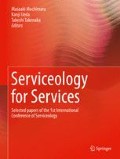Abstract
A design procedure of the customer satisfaction model, which is required for an artificial adaptive service system action, is introduced. And the methods to improve the model are presented using a statistical analysis and selection of several clustering methods that form the mathematical service model from the surveyed quantitative data. Using a case study about the hotel guest service, accuracies of those methods were evaluated by cross validations. As a result, the Naive Bayes clustering method and the REPTree algorithm showed good estimation of the customer satisfaction as much as about 40 %.
Access this chapter
Tax calculation will be finalised at checkout
Purchases are for personal use only
References
Asama H (2009) Service engineering. Proc Jpn Soc of Precis Eng 75(1):146–147
Lovelock CH, Wright LK (1995) Principles of service marketing and management. Prentice Hall, Englewood Cliffs
Furuta K (2003) Control of pendulum: from super mechano-system to human adaptive mechatronics. In: Proceedings of the IEEE conference on decision and control (CDC03), plenary, Hawaii, USA, pp 1498–1507
COGNIRON official web site. http://www.cogniron.org/. Accessed 20 Apr 2013
Tomiyama T (2002) Expansion of service engineering. In: Proceedings of the 6th symposium on research into artifacts, Tokyo, Japan, pp 45–58 (in Japanese)
Suzuki S, Ando M, Hashimoto H, Asama H (2011) Deliberation of value-sympathy model for adaptive service attendant system. In: Proceedings of the 37th annual conference of the IEEE industrial electronics society (IECON’11), Melbourne, Australia, pp 2039–2044
Normann R (1984) Service management: strategy and leadership in service business, 2nd edn. Wiley, New York
Kohonen T (1995) Self-organizing maps. Springer, Heidelberg, Berlin
Glaser BG, Strauss AL (1967) The discovery of grounded theory: strategies for qualitative research. Aldine Transaction, Chicago
Ono J (2010) Design of customer satisfaction model using JCSI. Market J 30(1):20–34
Witten IH, Frank E, Hall MA (2011) Data mining: practical machine learning tools and techniques, 3rd edn. Morgan Kaufmann Publishers, San Francisco
Bishop CM (2006) Pattern recognition and machine learning. Springer, New York
WEKA Official Home Page (2013) Machine learning group at university of Waikato. http://www.cs.waikato.ac.nz/ml/weka/. Accessed 10 Apr 2013
Jin M, Murakami M (2007) Authorship identification using random forests. Proc Inst Stat Math 55(2):255–268 (in Japanese)
Quinlan JR (1993) C4.5: Programs for machine learning. Morgan Kaufmann Publishers, San Francisco
Kohavi R (1996) Scaling up the accuracy of naive-bayes classifiers: a decision-tree hybrid. In: Proceedings of the 2nd international conference on knowledge discovery and data mining, Portland, USA, pp 202–207
Breiman L (2001) Random Forests. Mach Learn 45(1):5–32
Author information
Authors and Affiliations
Corresponding author
Editor information
Editors and Affiliations
Rights and permissions
Copyright information
© 2014 Springer Japan
About this paper
Cite this paper
Suzuki, S., Ando, M., Hashimoto, H., Asama, H. (2014). Design Procedure and Improvement of a Mathematical Modeling to Estimate Customer Satisfaction. In: Mochimaru, M., Ueda, K., Takenaka, T. (eds) Serviceology for Services. ICServ 2013. Springer, Tokyo. https://doi.org/10.1007/978-4-431-54816-4_2
Download citation
DOI: https://doi.org/10.1007/978-4-431-54816-4_2
Published:
Publisher Name: Springer, Tokyo
Print ISBN: 978-4-431-54815-7
Online ISBN: 978-4-431-54816-4
eBook Packages: EngineeringEngineering (R0)

